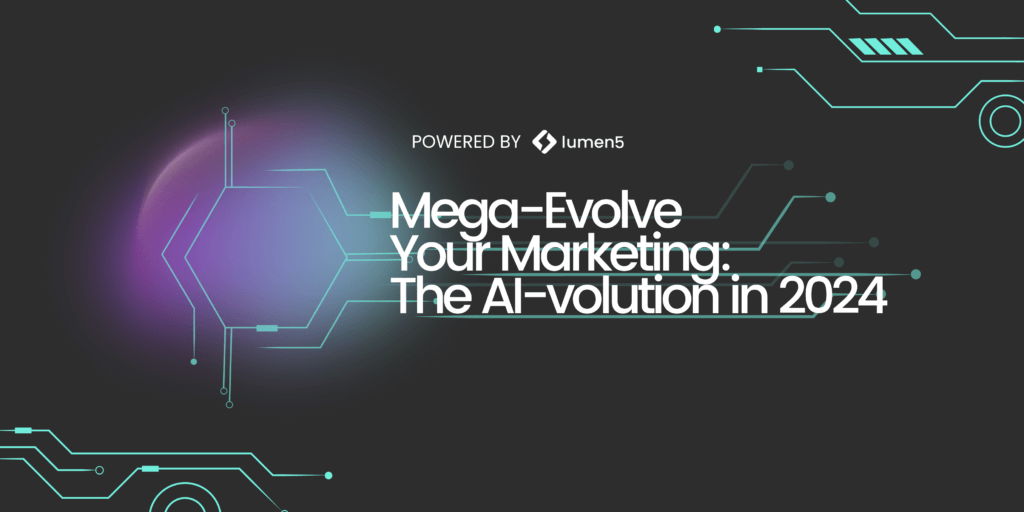
As we step into February 2024, Artificial Intelligence (AI) continues to evolve, and its impact on businesses is more prominent than ever. The global AI market is projected to reach $1.811 billion by 2030 and for those who haven’t explored AI yet, they’re falling way behind. No but really, what are you doing..
Businesses are exploring new and innovative ways to leverage this technology. However, as opportunities are endless, so are the risks. But with careful consideration and a thoughtful approach to implementation, this can be easily done.
New Frontiers in AI Leveraging
At the end of 2023, Google launched Gemini. But literally last week, Google launched Lumiere – some say it’s the best and newest video editing tool. (we think differently 😉) But as each week passes, new AI tools and solutions come out left and right. Here’s some new territory:
Personalization & Data
AI has now moved beyond basic content generation. As AI develops, the better it gets at finding out what really matters to consumers, curating hyper targeted experiences altogether — which consumers AND marketers love. 90% of leading marketers say personalization significantly contributes to business profitability and 91% of consumers are more likely to shop with brands that recognize, remember, and provide relevant offers and recommendations.

From forecasting future consumer behaviours and market trends to optimizing product offerings, AI is becoming the go-to tool for decision-makers. According to Gartner, providing tailored experiences to customers continues to be a challenge for over two-thirds (63 percent) of digital marketing executives.
But now, AI’s analyzation capabilities ensure businesses can make data-driven decisions with unprecedented accuracy and bring deeper and valuable insights to the tips of any marketer’s fingers. These insights then empower businesses to create personalized and engaging customer journeys where customers also believe the same (not just 60%) — whether it’s tailoring marketing messages, product recommendations for e-commerce, or switching up user interfaces.
Collaborative AI
Businesses are increasingly adopting collaborative AI tools, where human expertise combines with machine intelligence. Up to 80 percent of businesses use social collaboration tools for enhancing business processes. Taking a hybrid approach, this partnership increases creativity, problem-solving, and innovation leading to balance between efficiency and quality.
Most businesses saw boosts in project management and workflow, as 83% of professionals depend on technology to collaborate. Some tools such as Asana or Trello us AI to automate mundane tasks or assess team members’ availability to delegate appropriate tasks, avoiding burnout and maximizing productivity.
Global companies like MFAF and Cisco have taken advantage of AI tools like Lumen5 to expedite their marketing efforts tenfold. Despite geographic gaps, AI empowers human teams to connect and collaborate cross-departmentally in an effective manner.
And by providing employees with the right tools and information, their ability to solve problems and complete tasks fosters self confidence and independence, furthering team productivity and collaboration. According to Bit.AI’s survey, 82% of the participants felt that they would feel impacted if collaboration tools and technology were lost. Imagine going back to downloading Microsoft Word Docs and making sure “tracking changes” is turned on.. or exporting and downloading anything just to collaborate — my desktop would not be happy, nor would my brain.
De-risking AI in 2024
We all brushed up on our policies and learned to not solely rely on AI. AI learned our language better and in turn, we learned the strengths and weaknesses of AI. The end result: AI is a great place to start, but human fact-checking and double checking is still a necessity.
Enhanced Accountability Frameworks
Last year we focused on lack of oversight and accountability, but this big blackbox is no longer a risk to many AI companies. Now there are tools used for detailed auditing and tracing of decisions back to their sources, ensuring transparency and accountability in case of errors.
But furthermore, to tackle the accountability challenge, businesses are establishing comprehensive frameworks that clearly define the roles and responsibilities of both humans and AI systems. Involving more framework detailing AI is one way to mitigate this effectively, while also creating a culture of responsible AI usage.
Companies need to develop internal guidelines, outlining clear expectations and detailing procedures. These guidelines need cover aspects like content creation, decision-making processes, and the level of autonomy granted to AI.
Evolved Information Accuracy Measures (Information Accuracy, Bias)
AI hallucinations was a big topic in 2023, but as AI has gotten better at understanding our language model and machine learning, this is something more minimal. One big thing that came out of this huge concern was the evolution of information accuracy measures.
In 2024, businesses are placing a stronger emphasis on validating the accuracy of AI-generated information. Diligent fact-checking algorithms and external validation processes are being integrated into workflows to counter and/or catch any inaccuracies or “hallucinations” in AI outputs.
But also, proactive measures are taken to ensure the reliability of AI-derived insights. Businesses are investing in ethical AI training for their teams, ensuring that AI models are not inadvertently amplifying biases present in training data. Continuous monitoring and updates to AI models help maintain fairness and reduce the risk of unintentional discrimination.
AI Usage
Much like trends, concerns also come and go. And the next global concern: Global AI usage is the new top priority and trend. These changes may affect your existing business practices.
There has been talk about government regulations and laws around generative AI. Even Bill Gates and Sam Altman discussed this topic during their interview together and it also took center stage as a huge topic at the World Economic Forum.
According to the International Monetary Fund, almost 40% of employed people in the world are exposed to AI, which rises to 60% in advanced economies. And in the first few weeks of 2024, many countries (including the few listed earlier) have already enacted AI regulation laws (13 states in the US) as they try to react on this new reality.
There is still so much room for growth here and this is best to monitor and keep business practices up to date, to reflect any changes. We’ll also keep you informed as best as we can 🙂 (psst – this is how!)
Last year, we were like kids in a candy store — grabbing everything and putting it into our basket to buy. But this year, we’re smarter and better.
We realized AI was not going anywhere and actually, it was only getting better. Businesses are now focusing on the specific problems they aim to solve rather than adopting AI indiscriminately. Purpose-driven AI selection ensures a better fit for organizational needs, allowing for a more effective and seamless integration.
As we navigate the AI landscape in 2024, the opportunities are endless, but so are the responsibilities. Businesses that leverage AI with purpose, implement solid and built out safety measures, and embrace ethical practices are positioned to fully harness the power of AI.
By staying informed and adapting to the evolving AI landscape, businesses can confidently stride into the future successfully, reaping benefits while minimizing risks. Let’s pave the way for a marketing landscape that is not just efficient but genuinely exciting – striking the perfect balance between innovation and authenticity. And of course, being AI regulated and safe!!
The AI-volution is here!
More questions or interested in more conversations about AI and marketing in 2024? Check out our webinar!
Our webinar focuses on the future of AI for businesses. The AI-volution in 2024 will discuss key takeaways and exclusive POVs from AI experts about how they’ve built and implemented AI-based companies from the ground up. Discover the latest trends, practical insights, and expert perspectives that will empower the way you approach marketing and empower you to supercharge your marketing in 2024 and beyond.
Everything video, AI and marketing. All in one place.
Want to incorporate AI into your workflow? We’ve got you covered. With our tips and tricks, elevate your content game and strategy to win over leads.
Sign up and join 1000+ other marketers:







